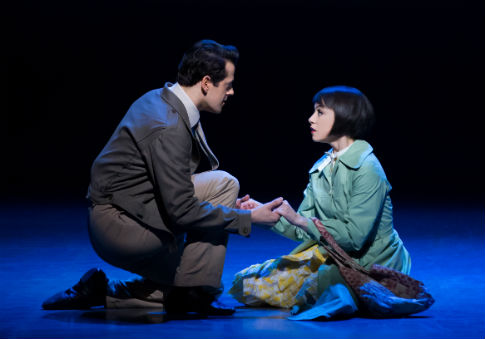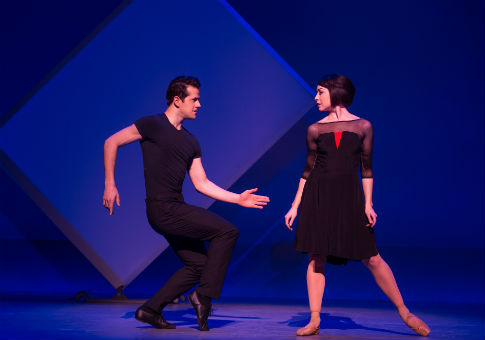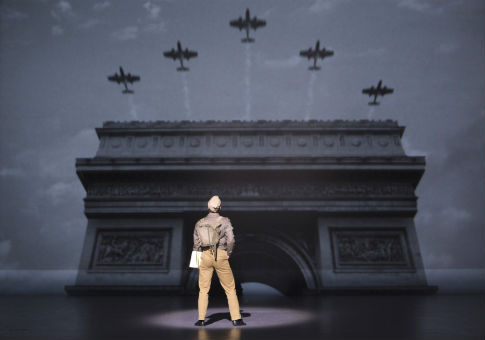The original An American In Paris—well, not the original original, the musical composition by George Gershwin—but the original 1951 movie, starring Gene Kelly, was thematic cotton candy, the high grade stuff that Golden Age Hollywood produced in its better moments. It had some technical daring, sure—the hallucinatory ballet sequence at its conclusion strained the boundaries of popular tastes—but the story itself was about boys and girls chasing each other around a bright, pain-free mid-century Paris while singing and dancing to Gershwin standards. Everyone was happy in the end, including the producers, who took home an Academy Award for Best Picture.
The adaptation of this movie playing now at Broadway’s Palace Theater is darker than its source material—darker, and richer. Gene Kelly’s pursuit of Leslie Caron happened an indeterminate few years after the conclusion of World War II, whereas the Broadway show opens in the immediate aftermath of the war. A harrowing opening dance sequence, set to Gershwin’s Concerto in F, depicts breadlines and the beating of collaborators, an aesthetic approach to 1945 that seems to owe a great deal to Steven Spielberg’s reimagining of the period. In the midst of the chaos, Jerry Mulligan (Gene Kelly’s old character, now played by Robert Fairchild) spots a young Parisian ingénue named Lise Dassin (now played by Leanne Cope) and we’re off.
To say that the new An American In Paris is a musical comedy doesn’t seem quite right. It is really a ballet—directed and choreographed by Christopher Wheeldon, and starring people like Fairchild and Cope, whose backgrounds are in dance—in which the characters sing, and even stop to talk from time to time. Couple this with some of the darker elements of the reworked plot—Lise, now Jewish, barely escaped the camps; Jerry’s musician friend Adam (Brandon Uranowitz), now also a veteran, seems to be an amputee—and you are pushing the boundaries of what Broadway-goers who think they are purchasing a ticket to a musical comedy might be willing to put up with.

It just so happens that they have bought a ticket for something beautiful and rare. I don’t believe I am alone in this assessment. I took in the show with a house of predominantly older folks, retirees, and tourists. The more conceptually daring the show got, including the second act’s reimagining of the movie’s ballet sequence, the more enthusiastically they responded. The applause for this climactic set-piece ballet almost stopped the production, and the standing ovation at the show’s end was one of the most honest I have ever seen, the house entirely on its feet for the rank-and-file dancers before a single lead performer came on stage. It was a Tuesday night.
One of the elements of the show’s appeal is its evocation of the spirit of late 1945. Jerry, fresh out of the Army and a painter, has torn up his return ticket for the USA and stayed on to make a go at an artist’s life on the Left Bank. Being the broad-shouldered, brash, American type, he attracts the attention of the ladies, including Milo Davenport (Jill Paice, channeling Cate Blanchett in full patrician mode) a wealthy young woman who wishes to establish herself as a patron of the arts. But Jerry has eyes only for Lise, a dancer in a ballet Milo is sponsoring, and for which Jerry is doing the designs. But, alors, Lise is engaged to Henri (Max von Essen), the son of a Parisian businessman, who secretly wants to be a singer. Not satisfied with a love quadrangle, the book (by Craig Lucas) manages to get Jerry’s friend Adam in on the action, too, by making him fall for Lise.
This love pentagon can get a bit unwieldy, but it does allow plenty of opportunities for Gershwin tunes. Robert Fairchild, playing Jerry, gives early evidence that he is going to own the production during "I’ve Got Beginner’s Luck," when, in pursuit of Lise, he manages to slide his corn-fed American frame weightlessly down a long department store counter without apparent strain, and with a surplus of aggressive charm. Gene Kelly would have been proud. By the end of the second act, he would have been worried about his job security.

All this dancing, which does more to advance the story than in any other recent Broadway production of which I am aware, takes place within a striking spectacle of a production design (by Bob Crowley) which makes heavy use of electronic projections to impressionistically suggest various Parisian locales. Of course, there are weak spots. For some reason, despite having been together for some time now, the leads’ comic timing is not always sure. The suggestion that a suppressed desire for the company of men has led Henri to pursue a career in showbiz seems forced, and downright cruel when the show’s conclusion implies that he is going to take up romantically with the jilted Milo.
But these are quibbles. It is tempting to deploy the old saw that this production has something for everyone, except that it is more than that—one of those rare shows that, indeed, can please different sorts of theatergoers, but also seems to be more than the sum of its parts. Most of all, as with the film it adapts, it is a celebration of George Gershwin’s music, and of an increasingly distant, more confident American century.
